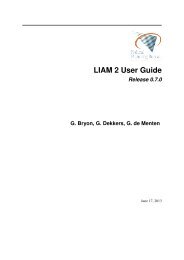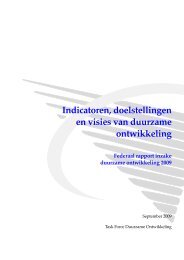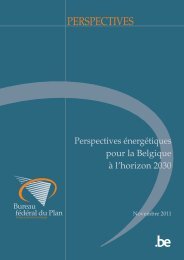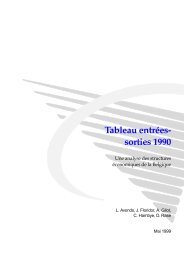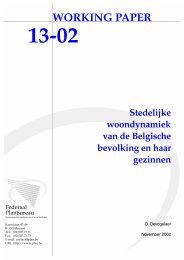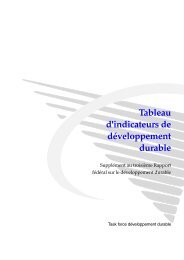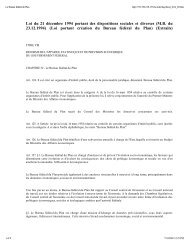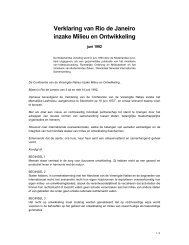LONG-TERM CARE USE AND SUPPLY IN EUROPE | 33 2010; Kadush<strong>in</strong>, 2004b), is ho<strong>use</strong>hold composition. In the next step, projected numbers of older persons by age category, gender <strong>and</strong> disability level are further divided accord<strong>in</strong>g to ho<strong>use</strong>hold composition (h) <strong>in</strong>to persons liv<strong>in</strong>g alone <strong>and</strong> persons liv<strong>in</strong>g with others (N a,g,d,h,t ). For each age x gender x disability group, the shares of persons liv<strong>in</strong>g alone <strong>and</strong> with others <strong>in</strong> the base year t0, Ph a,g,d,t0 , have been derived from national survey or SHARE data. The shares have been adjusted to match base year official national statistics of the population by ho<strong>use</strong>hold composition, if available. Age <strong>and</strong> gender specific adjustment factors Adj a,g have been calculated as follows: Adj , Ph , Ph ′ , (1) with Ph a,g be<strong>in</strong>g base year proportions of persons liv<strong>in</strong>g alone or with others by age <strong>and</strong> gender as derived from survey data <strong>and</strong> Ph’ a,g be<strong>in</strong>g the ‘official’ base year proportions. These adjustment factors are applied to Ph a,g,d,t0 , so as to obta<strong>in</strong> adjusted proportions: Ph ,,, Ph ,,, Adj , (2) In the base scenario, it is assumed that the base year ho<strong>use</strong>hold composition distribution by age, gender <strong>and</strong> disability will rema<strong>in</strong> constant over the projection horizon. The sensitivity to this assumption is explored <strong>in</strong> an alternative scenario. The projected numbers of persons aged 65 <strong>and</strong> over by age category, gender, disability level <strong>and</strong> ho<strong>use</strong>hold composition are thus calculated as follows: N ,,,, N ,,, Ph ,,, (3) c. Education The older population by age, gender, disability <strong>and</strong> ho<strong>use</strong>hold composition is further split by educational level. In several countries, education has been identified as a significant de<strong>term</strong><strong>in</strong>ant of LTC <strong>use</strong>, although the effects are generally not very strong (Van den Bosch et al., 2011; Gaugler et al., 2007; Geerts, 2010). For each age x gender x disability x ho<strong>use</strong>hold composition group, the distribution by educational level <strong>in</strong> the base year Pe a,g,d,h,t0 has been derived from national survey data or SHARE data. Three educational levels are dist<strong>in</strong>guished, us<strong>in</strong>g the International St<strong>and</strong>ard Classification of Education (ISCED 97): low (no or primary education; ISCED 0-1), medium (secondary education; ISCED 2-4) <strong>and</strong> high (tertiary education; ISCED 5-6). The base scenario assumes constant proportions of low, medium <strong>and</strong> high-educated older persons by age, gender, disability <strong>and</strong> ho<strong>use</strong>hold composition. The projected numbers of persons aged 65 <strong>and</strong> over by age category, gender, disability level, ho<strong>use</strong>hold composition <strong>and</strong> educational level are calculated as follows: N ,,,,, N ,,,, Pe ,,,, (4) d. Other characteristics F<strong>in</strong>ally, projected numbers of older persons by age, gender, disability, ho<strong>use</strong>hold composition <strong>and</strong> education, have been further split by characteristics that have been identified <strong>in</strong> Chapters 2 <strong>and</strong> 3 as significant drivers of residential or home <strong>care</strong> utilisation. Variables <strong>in</strong>cluded <strong>in</strong> the models are: number of limitations with <strong>in</strong>strumental activities of daily liv<strong>in</strong>g (IADLs), suffer<strong>in</strong>g from dementia or hav<strong>in</strong>g
34 | GEERTS, WILLEMÉ & COMAS-HERRERA cognitive limitations, hav<strong>in</strong>g children. The base year distribution has been derived from national survey data or SHARE data <strong>and</strong> has been kept constant over the projection horizon. 4.1.2 Projected numbers of <strong>care</strong> <strong>use</strong>rs by age, gender, disability <strong>and</strong> other relevant characteristics The second part of the model projects numbers of <strong>use</strong>rs of different categories of <strong>long</strong>-<strong>term</strong> <strong>care</strong> by age, gender, disability <strong>and</strong> other relevant characteristics. There<strong>for</strong>e, the projected numbers of older persons <strong>in</strong> subgroups by age, gender, disability <strong>and</strong> other characteristics (part 1 of the model) are comb<strong>in</strong>ed with functions relat<strong>in</strong>g <strong>use</strong> of <strong>care</strong> to these characteristics. Five <strong>care</strong> <strong>use</strong> categories are <strong>in</strong>cluded <strong>in</strong> the model. Besides us<strong>in</strong>g no <strong>care</strong>, the model dist<strong>in</strong>guishes <strong>use</strong> of residential <strong>care</strong> <strong>and</strong> three home <strong>care</strong> categories: <strong>in</strong><strong>for</strong>mal personal <strong>care</strong> only, <strong>for</strong>mal personal <strong>care</strong> only, both <strong>in</strong><strong>for</strong>mal <strong>and</strong> <strong>for</strong>mal personal <strong>care</strong>. For reasons expla<strong>in</strong>ed <strong>in</strong> Chapter 3, <strong>use</strong> of <strong>for</strong>mal or <strong>in</strong><strong>for</strong>mal help with ho<strong>use</strong>hold tasks is not <strong>in</strong>cluded <strong>in</strong> the model. Estimated probabilities of <strong>care</strong> <strong>use</strong> have been derived from the b<strong>in</strong>ary (residential <strong>care</strong>) <strong>and</strong> mult<strong>in</strong>omial (home <strong>care</strong>) models, described <strong>in</strong> Chapters 2 <strong>and</strong> 3, with age, gender, disability <strong>and</strong> the other relevant characteristics as <strong>in</strong>dependent variables. The projection of <strong>care</strong> <strong>use</strong>rs proceeds <strong>in</strong> two stages (see figure 1). First, N a,g,d,h,e,o,t , the projected numbers of older persons by age a, gender g, disability level d, ho<strong>use</strong>hold composition h, educational level e <strong>and</strong> other characteristics o <strong>in</strong> year t, are split <strong>in</strong>to persons resid<strong>in</strong>g at home Nhome <strong>and</strong> persons us<strong>in</strong>g residential <strong>care</strong> Nres, us<strong>in</strong>g fitted values of the logistic regression models of residential <strong>care</strong> <strong>use</strong> described <strong>in</strong> Chapter 2. For each projection year t, cell numbers N a,g,d,h,e,o,t are multiplied with estimated probabilities of residential <strong>care</strong> <strong>use</strong> Pres a,g,d,h,e,o to produce numbers of older persons <strong>in</strong> residential <strong>care</strong> Nres a,g,d,h,e,o,t : ,,,,,, ,,,,,, ,,,,, (5) The numbers of persons <strong>in</strong> residential <strong>care</strong> are subtracted from total cell numbers to yield numbers of persons resid<strong>in</strong>g at home Nhome a,g,d,h,e,o,t: Nhome ,,,,,, N ,,,,,, Nres ,,,,,, (6) In the second stage, projected numbers of older persons resid<strong>in</strong>g at home by age, gender, disability <strong>and</strong> other characteristics are further split <strong>in</strong>to persons us<strong>in</strong>g no <strong>care</strong>, <strong>use</strong>rs of <strong>in</strong><strong>for</strong>mal <strong>care</strong> only, <strong>use</strong>rs of <strong>for</strong>mal <strong>care</strong> only, <strong>use</strong>rs of both <strong>in</strong><strong>for</strong>mal <strong>and</strong> <strong>for</strong>mal <strong>care</strong>, us<strong>in</strong>g fitted values of the mult<strong>in</strong>omial logistic models described <strong>in</strong> Chapter 3. For each projection year t, cell numbers Nhome a,g,d,h,e,o,t are multiplied with estimated probabilities of us<strong>in</strong>g different categories of home <strong>care</strong> i Ph<strong>care</strong> i,a,g,d,h,e,o to produce numbers of older persons <strong>in</strong> different home <strong>care</strong> categories Nh<strong>care</strong> i,a,g,d,h,e,o,t : Nh<strong>care</strong> ,,,,,,, Nhome ,,,,,, Ph<strong>care</strong> ,,,,,, with i=home <strong>care</strong> category: no <strong>care</strong> (NC), <strong>for</strong>mal <strong>care</strong> only (FC), <strong>in</strong><strong>for</strong>mal <strong>care</strong> only (IC), both <strong>for</strong>mal <strong>and</strong> <strong>in</strong><strong>for</strong>mal <strong>care</strong> (IFC) (7) Total numbers of <strong>for</strong>mal home <strong>care</strong> <strong>use</strong>rs by age, gender, disability <strong>and</strong> other characteristics Nh<strong>for</strong>m a,g,d,h,e,o,t are calculated by summ<strong>in</strong>g the numbers of persons us<strong>in</strong>g <strong>for</strong>mal <strong>care</strong> only <strong>and</strong> the numbers of persons comb<strong>in</strong><strong>in</strong>g <strong>for</strong>mal <strong>and</strong> <strong>in</strong><strong>for</strong>mal <strong>care</strong>: Nh<strong>for</strong>m ,,,,,, Nh<strong>care</strong> FC,,,,,,, Nh<strong>care</strong> FIC,,,,,,, (8) Total numbers of <strong>for</strong>mal <strong>care</strong> <strong>use</strong>rs by age, gender, disability <strong>and</strong> other characteristics N<strong>for</strong>m a,g,d,h,e,o,t are calculated by summ<strong>in</strong>g the numbers of persons us<strong>in</strong>g <strong>for</strong>mal home <strong>care</strong> <strong>and</strong> the numbers of persons us<strong>in</strong>g residential <strong>care</strong>:
- Page 1 and 2: ANCIEN Assessing Needs of Care in E
- Page 3 and 4: 4.3.2 Household composition project
- Page 5 and 6: Table 5.2 Provision of informal per
- Page 7 and 8: Figure 5.5 Estimated numbers of peo
- Page 9 and 10: 2 | GEERTS, WILLEMÉ & MOT (EDS) Ta
- Page 11 and 12: 2. Determinants of institutionalisa
- Page 13 and 14: 6 | MOT, SCHULZ, SOWA, VEGAS & WITT
- Page 15 and 16: 8 | MOT, SCHULZ, SOWA, VEGAS & WITT
- Page 17 and 18: 10 | MOT, SCHULZ, SOWA, VEGAS & WIT
- Page 19 and 20: 12 | MOT, SCHULZ, SOWA, VEGAS & WIT
- Page 21 and 22: 14 | MOT, SCHULZ, SOWA, VEGAS & WIT
- Page 23 and 24: 16 | JOANNA GEERTS 1973) has become
- Page 25 and 26: 18 | JOANNA GEERTS not including he
- Page 27 and 28: 20 | JOANNA GEERTS Table 3.1 Determ
- Page 29 and 30: 22 | JOANNA GEERTS 3.3.3 Spain Tabl
- Page 31 and 32: 24 | JOANNA GEERTS formal home care
- Page 33 and 34: 26 | JOANNA GEERTS Figure 3.3 Predi
- Page 35 and 36: 28 | JOANNA GEERTS Brandt, M., K. H
- Page 37 and 38: 4. Long-term care use in Europe: Pr
- Page 39: 32 | GEERTS, WILLEMÉ & COMAS-HERRE
- Page 43 and 44: 36 | GEERTS, WILLEMÉ & COMAS-HERRE
- Page 45 and 46: 38 | GEERTS, WILLEMÉ & COMAS-HERRE
- Page 47 and 48: 40 | GEERTS, WILLEMÉ & COMAS-HERRE
- Page 49 and 50: 42 | GEERTS, WILLEMÉ & COMAS-HERRE
- Page 51 and 52: 44 | GEERTS, WILLEMÉ & COMAS-HERRE
- Page 53 and 54: 46 | GEERTS, WILLEMÉ & COMAS-HERRE
- Page 55 and 56: 48 | GEERTS, WILLEMÉ & COMAS-HERRE
- Page 57 and 58: 50 | GEERTS, WILLEMÉ & COMAS-HERRE
- Page 59 and 60: 52 | GEERTS, WILLEMÉ & COMAS-HERRE
- Page 61 and 62: 54 | GEERTS, WILLEMÉ & COMAS-HERRE
- Page 63 and 64: 56 | GEERTS, WILLEMÉ & COMAS-HERRE
- Page 65 and 66: 58 | GEERTS, WILLEMÉ & COMAS-HERRE
- Page 67 and 68: 60 | GEERTS, WILLEMÉ & COMAS-HERRE
- Page 69 and 70: 62 | GEERTS, WILLEMÉ & COMAS-HERRE
- Page 71 and 72: 64 | GEERTS, WILLEMÉ & COMAS-HERRE
- Page 73 and 74: 66 | GEERTS, WILLEMÉ & COMAS-HERRE
- Page 75 and 76: 68 | GEERTS, WILLEMÉ & COMAS-HERRE
- Page 77 and 78: 70 | GEERTS, WILLEMÉ & COMAS-HERRE
- Page 79 and 80: 72 | GEERTS, WILLEMÉ & COMAS-HERRE
- Page 81 and 82: 74 | GEERTS, WILLEMÉ & COMAS-HERRE
- Page 83 and 84: 5. Modelling the future supply of i
- Page 85 and 86: 78 | PICKARD & KING The SHARE data
- Page 87 and 88: 80 | PICKARD & KING in the ANCIEN s
- Page 89 and 90: 82 | PICKARD & KING Logistic regres
- Page 91 and 92:
84 | PICKARD & KING Figure 5.3 Prev
- Page 93 and 94:
86 | PICKARD & KING Table 5.4 Provi
- Page 95 and 96:
88 | PICKARD & KING In addition to
- Page 97 and 98:
90 | PICKARD & KING Table 5.7 Estim
- Page 99 and 100:
92 | PICKARD & KING Figure 5.5 Esti
- Page 101 and 102:
94 | PICKARD & KING In Spain, there
- Page 103 and 104:
96 | PICKARD & KING rises by no mor
- Page 105 and 106:
98 | PICKARD & KING Figure 5.10 Per
- Page 107 and 108:
100 | PICKARD & KING Figure 5.12 Pe
- Page 109 and 110:
102 | PICKARD & KING Figure 5.15 Pe
- Page 111 and 112:
104 | PICKARD & KING The results sh
- Page 113 and 114:
106 | PICKARD & KING Pickard, L. (2
- Page 115 and 116:
108 | WITTWER & GOLTZ The report bu
- Page 117 and 118:
110 | WITTWER & GOLTZ For the proje
- Page 119 and 120:
112 | WITTWER & GOLTZ a decline in
- Page 121 and 122:
7. Conclusions Linda Pickard and De
- Page 123 and 124:
116 | PICKARD, KING, GEERTS & WILLE
- Page 125 and 126:
118 | PICKARD, KING, GEERTS & WILLE
- Page 127 and 128:
120 | PICKARD, KING, GEERTS & WILLE
- Page 129 and 130:
122 | PICKARD, KING, GEERTS & WILLE
- Page 131 and 132:
124 | PICKARD, KING, GEERTS & WILLE
- Page 133 and 134:
126 | PICKARD, KING, GEERTS & WILLE
- Page 135 and 136:
128 | PICKARD, KING, GEERTS & WILLE
- Page 137:
ANCIEN Assessing Needs of Care in E



